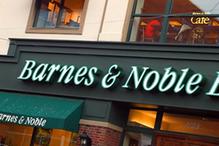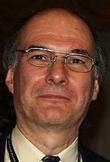 In a lead business section story yesterday titled "The Bookstore's Last Stand," the New York Times profiled Barnes & Noble's effort to reinvent itself in the digital age and major publishers' belief that B&N's fate is crucial to the future of the book industry--as a bulwark against Amazon and as a place where readers discover books, even if they buy them elsewhere.
In a lead business section story yesterday titled "The Bookstore's Last Stand," the New York Times profiled Barnes & Noble's effort to reinvent itself in the digital age and major publishers' belief that B&N's fate is crucial to the future of the book industry--as a bulwark against Amazon and as a place where readers discover books, even if they buy them elsewhere.
It's a vast subject and a portrait difficult to paint in only a few newspaper columns, but for all the detail, the effort strikes us as more of a sketch, one constrained by perceived wisdom.
A few minor quibbles before the major concern: the article seems to have missed that B. Dalton Bookseller was bought and eventually shut down by B&N; B&N's roots are in Len Riggio's campus bookstores, which bought the sole B&N store and took its name, not the other way around; being a public company, which in the past was so beneficial to B&N and the Riggio family, is now a hindrance to the company (one example: the recent John Malone-inspired proposal to spin off digital operations from B&N).
But the biggest problem with the article, starting with its title, is the thesis that the bricks-and-mortar bookstore is dying. The Times does note that B&N had the best holiday in years ("surprisingly robust"), but this is glanced over in the somewhat dated storyline that Amazon and e-books will sweep away all traditional elements of book publishing, including bookstores, the printed book and publishers. Books-A-Million, which expanded into a significant number of closed Borders locations, doesn't warrant a mention. And indies are only a sad footnote here: "Since 2002, the United States has lost roughly 500 independent bookstores--nearly one out of five." That's roughly 50 a year, and doesn't take into account either the "natural" closing of stores or the opening of new stores or the addition by existing stores of new locations. And, of course, you wouldn't know that for many indies, 2011 was their best year ever. Indies do have less than 10% of the market, but they are in a good position at the moment and have an influence far beyond that number.
Luckily, B&N CEO William Lynch sounds level-headed. He seemed to shrug off the company's low share price, stating, "Had we not launched devices and spent the money we invested in the Nook, investors and analysts would have said, 'Barnes & Noble is crazy, and they're going to go away.' " And the company has a hit in the Nook, which in a little over two years has claimed nearly 30% of the e-reader device market. Another Nook is on the way, and the company soon will begin selling it abroad.
--- With serendipitous timing, only last week American Booksellers Association CEO Oren Teicher presented a case for indies at the Digital Book World conference in New York City.
With serendipitous timing, only last week American Booksellers Association CEO Oren Teicher presented a case for indies at the Digital Book World conference in New York City.
"For many years now, I've been known to paraphrase Mark Twain and declare that the reports of the death of independent bookselling are premature, and until this year it was often to dubious audiences," he stated. "Not only are indie booksellers surviving in extraordinarily turbulent times, but many--believe it or not--are thriving, even recording record sales numbers for the fourth quarter of last year."
Much of his message was similar to that at the Winter Institute two weeks ago (Shelf Awareness, January 19, 2012), but among other news:
In 2011, there was an 80% increase in ABA member stores using the IndieCommerce platform--with 369 stores at the end of the year. (Some stores use other website platforms.)
In December, there was a 300% increase in the number of IndieCommerce stores with sales of more than $10,000, and the average gross sales per store rose 26%.
Sales of Google eBooks at IndieCommerce stores doubled in December compared to December 2010, and for the year sales of e-books were 5.2% of all IndieCommerce sales.
E-book bestsellers are the same as print bestsellers and this past year included, at #1, State of Wonder by Ann Patchett, The Tiger's Wife by Téa Obreht, The Marriage Plot by Jeffrey Eugenides and Steve Jobs by Walter Isaacson.
So far, most IndieCommerce customers are buying either print books or e-books: only 2% of the time does an e-book order include a print book.
IndieCommerce customers who buy e-books are 2.5 times more likely to come back to the store's website for further purchases.
After the ABA last year asked publishers to create "new ways of doing business that recognize the importance of indies as both a sales channel and an essential catalyst to sales in other channels," Teicher said, some publishers are working with certain bookstores on tests that include "consignment arrangements, extended dating for invoices, publisher rebates for sales of selected titles, trading co-op in return for title placement in stores or a broader representation of inventory, focused category promotion, new ways of bundling e-books and print books, and more."
Teicher added: "On behalf of authors, readers and our industry, we must be committed to sustaining the physical places where consumers can discover their next great read, no matter where they ultimately buy that title, and in whatever format... Despite all the tumult and change we are living through, books (and, more importantly, the way they change people's lives) are not going away."

